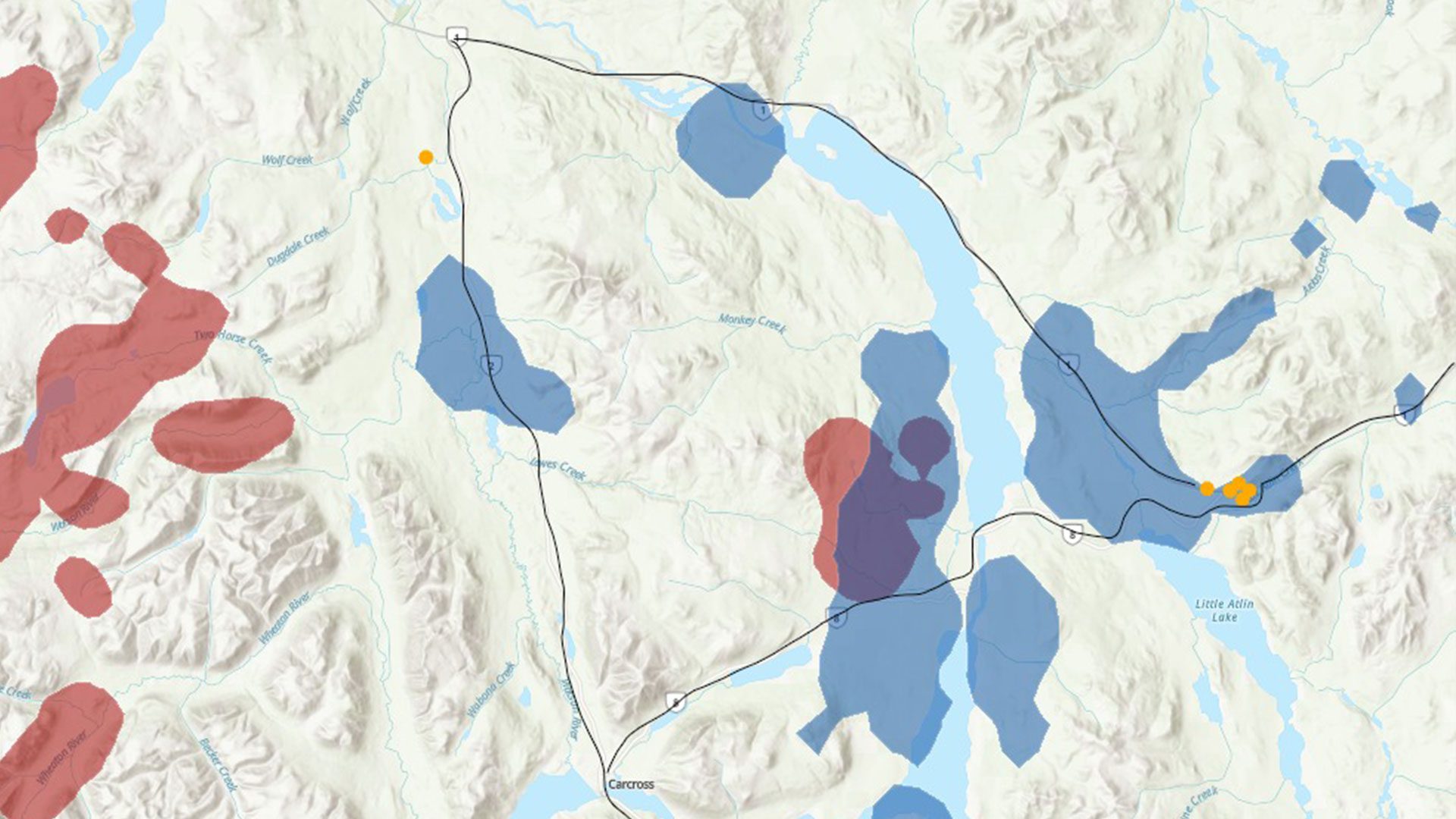Woodland caribou are a common sight along highways in southern Yukon, but some stretches are posing as a major hazard for the Southern Lakes herd.
According to data collected by the Carcross/Tagish Renewable Resources Council (CTRRC), seven Southern Lakes caribou were killed this winter so far in highway vehicle collisions.
Five of the collisions occurred along the Alaska Highway between the areas of Jake’s Corner and Judas Creek. The area is considered especially dangerous for caribou as it intersects with prime caribou winter range.
Prior to the 1990s, the Southern Lakes herd, which is composed of the Carcross, Laberge and Ibex herds, was almost depleted due to overhunting.
Thanks to a recovery program, including First Nations voluntarily restricting their harvests, and a prohibition of licensed hunting, the herd totals around 3,000 animals today.
Don Toews, CTRRC’s chair, said the Carcross herd in particular is greatly impacted as its winter range includes the stretch of highway between Jake’s Corner and Judas Creek.
He said although the herd has since rebounded from around 300 animals to around 1,200 to 1,500, he’s worried too many caribou are being lost to highway collisions.
“Now that we have 1,200 to 1,500, we have vehicle collisions that we didn’t have before,” he said.
While seven to eight caribou are typically lost to collisions each year, Toews said in recent years as many as 12 have been killed.
“Twelve caribou is one per cent of the total herd,” he said.
Toews noted January is a particularly dangerous time of the year for the caribou as there’s limited daylight hours. The herd is also more active during dusk and dawn and they can be difficult to spot in the dark.
Toews said it’s not uncommon for drivers to not notice caribou until it’s too late. The number of deaths can be especially devastating if big trucks are involved.
“Truckers are a big concern, because they can’t stop or swerve on the highway. Very often it’s a herd of caribou in front of them, so they don’t hit one animal, they hit three or four or five,” he said.
“It’s just a reality of highways crossing through caribou’s winter range, and we have to manage it and deal with it, we can’t change it.”
According to Toews, 70 per cent of the Southern Lakes’ herd fatalities involve pregnant females.
Jaylene Groots, acting Southern Lakes regional biologist, said female mortality often has a bigger impact on a caribou herd than with males.
“The loss of a cow means the loss of all the calves she would have had throughout her lifetime that might have been recruited into the population. For recovering herds like the Carcross herd, adult survival is pretty important,” she said.
Other roadways, such as the Tagish Road, Carcross Road and the North Klondike Highway also experience collisions.
Groots said it’s important motorists drive appropriately for the weather conditions, especially in winter when it’s icy.
“We encourage people to slow down and be a bit more vigilant in areas where we know we have a lot of collisions,” she said.
The importance of caribou

Edna Helm, a Carcross/Tagish First Nation citizen who lives in the community of Carcross in Yukon’s Southern Lakes region is also concerned.
She said caribou, along with other wildlife, are important to First Nations people in Yukon and play a strong spiritual and cultural role.
“Moose, caribou, anything, it lightens my spirits up to see something there,” she said.
“The caribou, to see them coming back now and then you watch them – they’re magnificent. It lifts your spirits to know that they’re there, especially when you almost lost them.”
While drivers are encouraged to report collisions, Helm suspects that’s not always the case.
“Nobody reports a lot of these things, so I think there might be a lot more hit because they can go off on the side of the road and you won’t find them,” she said.
Helm also noted it’s not just caribou that are falling victim to the highway.
“Just the other day there was a yearling moose killed, and then the mother is standing on the other side of the road looking.”
Groots said other areas of highways are “hotspots” for other species, such as a moose collision hotspot near Dawson City.
Helm said she’s saddened by the collisions and hopes public awareness and education will help prevent more animals from being lost.
“Somehow we got to put the word out there that it’s only for a certain time of the year they’re there. I’m sure that we can work something out so they can slow down.”
For the last few years CTRRC along with the departments of Environment and Highways and Public Works have been working to warn drivers about the Carcross herd.
Initiatives include placing lighted signs at strategic points at the north and south ends of the corridor on the Alaska Highway and clearing vegetation in certain areas so drivers have a better line of sight.
Since the Alaska Highway is here to stay, Toews said the recovering caribou population depends on drivers being cautious.
“You really have to be aware and slow down and drive smart.”









